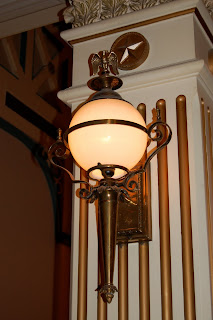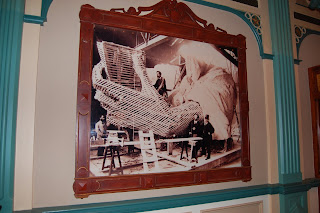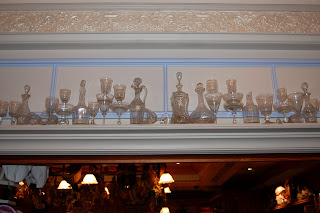Running along the opposite side of Main Street and connecting to Discoveryland is the Discovery Arcade. While the thematic transition to Frontierland in the Liberty Arcade is handled through the telling of the story of the Statue of Liberty, the Discovery Arcade carries on Main Street's themes of progress and invention with fantastic visions of things to come.
Here, the arcade is a bit more dimly lit, with richer woods and darker colors. Rather than Lady Liberty, the colonnades feature an image of Leonardo da Vinci's Vitruvian Man, a symbol of the combination of science and art prominent not only during the Renaissance but throughout Main Street and Discoveryland as well.
The spirit of invention is evident in the exhibits in the Discovery Arcade, comprised predominantly of original patent models from the 19th century. Such models were once required by the United States Patent Office. By the early-1900s, with space at a premium and storage costs soaring, Congress opted to sell the models, many of which ended up in the private collection of American designer and inventor Cliff Petersen. Several dozen gems from that collection are on display here at Disneyland Paris.
Among the models is one for the Wheel designed by George Washington Gale Ferris for the 1893 World's Columbian Exposition in Chicago (the World's Fair on which Walt Disney's father, Elias, served as a contractor).
The inventive nature of the people of Main Street creates a general sense of optimism about the future. Visions of that potential future are also on display in the Discovery Arcade, in the form of a series of large illustrations depicting what major American cities might look like in the far off years of 1996, 1999 or even the year 2000 (click the images to see them larger)!
Created in the style of French illustrator Albert Robida, known for his trilogy of futuristic novels, the posters imagine a world filled with golden towers, mechanical wonders and streamlined dirigibles. One such airship is also displayed in model form. It's the Hyperion, seen in the 1974 Disney film The Island at the Top of the World and brought to full-scale fruition in neighboring Discoveryland.


































































